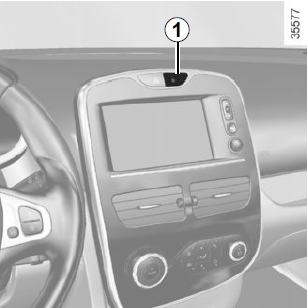Renault Clio: Renault anti-intruder device (raid)
Operating principle

After the vehicle is started, the system automatically locks the doors when you are driving at approximately 6 mph (10 km/h) and over.
The door can be unlocked:
- by pressing the door unlocking button 1.
- by opening a front door (vehicle stationary).
NB: if a door is opened or closed, it will automatically lock again when the vehicle reaches a speed of 6 mph (10 km/h).
Activating/deactivating the function
With the engine running, press button 1 for approximately five seconds until you hear a beep.
Operating faults
If you experience an operating fault (no automatic locking, the indicator light incorporated in button 1 does not light up when trying to lock the opening elements, etc.), firstly check that the opening elements are properly closed.
If they are properly closed, contact an authorised dealer.
| Driver’s responsibility If you decide to keep the doors locked when you are driving, remember that it may be more difficult for those assisting you to gain access to the passenger compartment in the event of an emergency. |
READ NEXT:
 Front headrests
Front headrests
To raise the headrest
Pull the headrest upwards to the desired
height. Check that it is correctly
locked.
To lower the headrest
Press button 1 and guide the headrest
down to the desired heig
 Front seats
Front seats
To move the seat forwards or backwards
Lift handle 1 to unlock. Release the
handle once the seat is in the correct
position and ensure that the seat is
locked.
For safety reasons, carr
 Seat belts
Seat belts
Always wear your seat belt when travelling
in your vehicle. You must also
comply with the legislation of the particular
country you are in.
Make sure that the rear bench seat
is locked i
SEE MORE:
 Instrument Panel
Instrument Panel
Clock: Before/after repair procedure
SETTING THE CLOCK
WITHOUT NAVIGATION AID, and RADIO NO. 01
or RADIO NO. 02 or RADIO NO. 03 or RADIO NO.
04 or RADIO NO. 05 or RADIO NO. 06 or RADIO
NO. 07 or RADIO NO. 08
Switch on the ignition.
Switch the radio on.
Adjusting the hour: press button (1) to
 Flow actuator: Removal - Refitting
Flow actuator: Removal - Refitting
K9K, and 750 or 752 or 766 or 768
IMPORTANT
Before carrying out any work on the injection system,
check using the Diagnostic tool :
that the injector rail is not under pressure,
that the fuel temperature is not too high.
It is essential to respect the safety and cleanliness
advice whenever work
© 2016-2026 Copyright Renault Clio Owners Club

